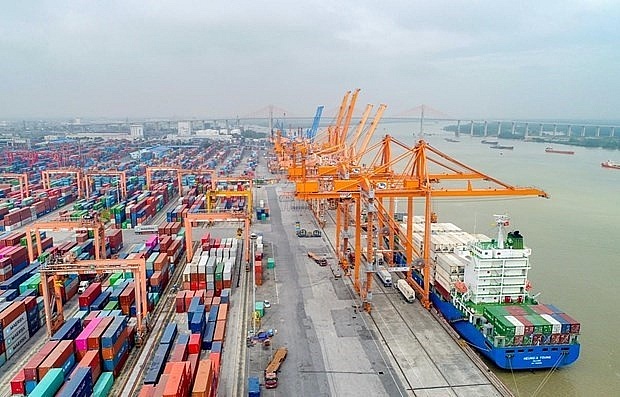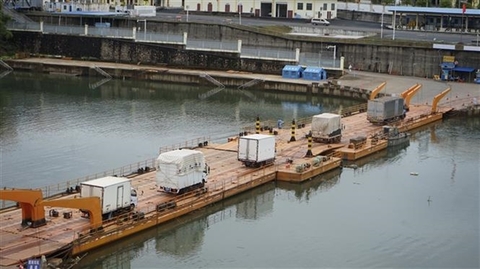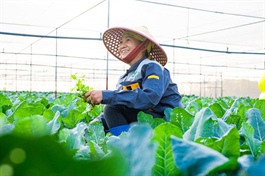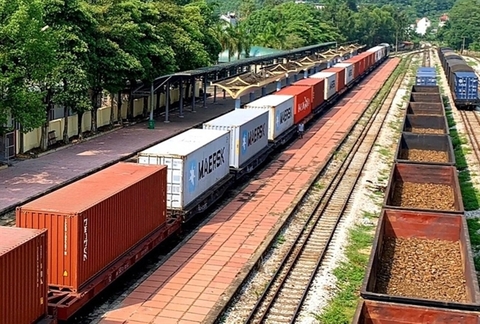Long-term plan encourages foreign investment in seaport development
Long-term plan encourages foreign investment in seaport development
The planning of Vietnam's seaports for the next decade sets a target of creating a breakthrough in the seaport system and the attraction of more foreign investment.

Seaports play key role in goods transport
Under a Prime Minister’s decision approving the Vietnam’s seaport plan in the 2021-2030 period with a vision to 2050, seaports are divided into different groups depending on the scale and function. The seaport system is connected with railway and waterway routes as well as the national highway and local road system.
The first group includes five northern ports in Hai Phong, Quang Ninh, Thai Binh, Nam Dinh and Ninh Binh. They are set to handle 305-357 million tonnes of cargo and 162,000-164,000 passengers by 2030, with annual growth of 5-5.3 percent and 1.5-1.6 percent, respectively, by 2050.
The second group consists of six ports in the northern part of the central region, namely Thanh Hoa, Nghe An, Ha Tinh, Quang Binh, Quang Tri and Thua Thien-Hue; while the third one features eight ports in the southern part of the central region - Da Nang, Quang Nam, Quang Ngai, Binh Dinh, Phu Yen, Khanh Hoa, Ninh Thuan and Binh Thuan.
The fourth group comprising five ports in Ho Chi Minh City and the southern provinces of Dong Nai, Ba Ria-Vung Tau, Binh Duong and Long An are set to handle the largest share of cargo volume – from 461-540 million tonnes – by 2030 and the goods volume going through the ports is forecast to grow 3.5-3.8 percent by 2050.
The last one consists of 12 ports in Can Tho City and the provinces of Dong Thap, Tien Giang, Vinh Long, Benh Tre, An Giang, Hau Giang, Soc Trang, Tra Vinh, Ca Mau, Bac Lieu and Kien Giang in the Mekong Delta. They will focus on serving passenger transport with 6.1 – 6.2 million annually by 2030, the largest among the five groups.
The planning gives priority to upgrading infrastructure of international gateway ports such as Lach Huyen Port in Hai Phong and Cai Mep Port in Ba Ria – Vung Tau. Meanwhile, appropriate mechanisms and policies will be studied to improve the international transhipment port in Van Phong, Khanh Hoa province.
According to the planning, Vietnam has two special seaports including Hai Phong and Ba Ria – Vung Tau, 15 seaports of first class, six seaports of second class and 13 seaports of third class.
The seaport system is expected to handle 1,140 to 1,423 million tonnes of cargo, including 38 to 47 million TEUs of container cargo, and transport about 10.1 to 10.3 million passengers.
Total investment needed for the scheme until 2030 is about 313 trillion VND (13.79 billion USD).
Le Tan Dat, Deputy General Director of Construction Consultation Joint Stock Company for Maritime Building held that transport connection is key in seaport operation. He lauded the planning for giving directions in forming a transport network to promote the strengths of each region and area.
Dat noted that the planning also clarifies projects to receive capital priority in different groups, thus optimising the exploitation of the ports.
Meanwhile, Ho Kim Lan, General Secretary of the Vietnam Seaports Association (VPA), said that the planning was based on careful calculation of the market in particular area, taking seaports as the core in the network of transport system connecting localities for highest convenience.
Lan held that the development of the railway system in major seaport areas will help ease overload in road transport.
Diversifying investment attraction forms
In the 2011-2020 period, the mobilisation of capital from different sources in society in the maritime sector was conducted effectively. Among 202 trillion VND mobilised, 173 trillion came from businesses, accounting for 86 percent.
Hoang Hong Giang, Vice Director of the Vietnam Maritime Administration, said that with the motto that seaport infrastructure should be developed one step ahead and the planning of the seaport system needs a long-term vision, policies on the diversification of capital resources for seaport development in Vietnam that were stated in the planning showed positive outcomes. So far, nearly 100 percent of Vietnam’s seaport infrastructure has been invested using capital raised from different sources in society, he noted.
Giang said that in recent years, many big foreign players have engaged in building and exploiting seaports in Vietnam, including PSA from Singapore, APMT from Denmark, Hutchison Port Holding of Hong Kong (China), Mitsui O.S.K line from Japan, and Wanhai Lines from Taiwan (China).
Thanks to the early opening doors to welcome foreign investors, seaport has become the leading sector in attracting foreign investment of Vietnam in the recent 10 years. With the construction of many deep-water seaports in the Cai Mep-Thi Vai and Lach Huyen areas, Vietnamese export goods have been directly transported to Europe and North America without having to transit in seaports in Singapore or Hong Kong, thus improving the competitiveness for the Vietnamese economy, he said.
“Authorised agencies will promptly complete mechanisms to mobilise different resources inside and outside the country for the sector through suitable investment forms in line with the regulations,” Giang stated.





















